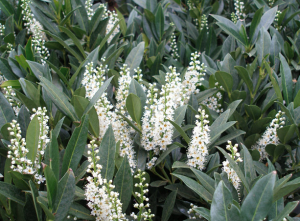What made you decide to become a landscape designer, and how long have you been designing for RLN?
I have always been an avid camper since a very young age, and I’d often go on camping trips with my dad. The more rugged and secluded the State Park or camp sites, the better. Even today, I will wander through the woods to simply observe. I wanted to recreate the peaceful feeling of being in the woods brought me one day. When it came time to choose my career path, my high school guidance counselor, who knew about my love of nature, recommended Delaware Valley University and their Ornamental Horticulture and Environmental Design program. My sights were set. Upon graduation in 2004, I started working immediately at Rutgers Landscape & Nursery and haven’t looked back!
How would you describe your design style? What is your specialty?
My design style leans towards the naturally built environment, and I use as many native plants possible from our region.
Some of the advantages of gardening with native or indigenous plants are:
~ They require less fertilizer
~ Native plants require less water
~ They can significantly reduce water runoff and help prevent erosion and flooding
~ Native plants help reduce air pollution
~They provide food and shelter (nectar, pollen, seeds, leaves and stems) for wildlife
~They promote biodiversity and stewardship of our natural heritage
~Native plants are beautiful and increase scenic values
~ They are unlikely to be invasive
It feels good to help restore a landscape back to its original form, especially now with all of the irresponsible developing that occurs. Using indigenous plants is like eating healthy — it’s what we all should be doing, yet that’s not always the case.
What’s your favorite botanical garden to visit?
People laugh at me because I’m not a big fan of arboretums. There is a place in Philadelphia, along the water that is called the Race Street Pier. It’s a tremendous park and I love spending time there.
What are the top three colors in your design color palette?
White would be number one when it comes to the design color palette. I love the pure orange color the Exbury Azaleas and Butterfly Weed can bring to a landscape. Pink is always a nice touch, whether it’s with a Redbud tree, Joe Pye Weed, or even Clethra which can incorporate white and pink in the same flower.
What’s your favorite season, and what are your favorite plants/trees to see blooming at that time?
Fall for sure. The reds, oranges and the yellows blended together can make a real statement. The Black Gum tree and the Red Maple’s fall color stand out the most to me.
What’s your favorite foundation plant and why?
I would say Inkberry for sun/shade and although it’s not native, the Cherry Laurel is a nice choice too.
What’s your favorite specimen tree and why?
The American Beech because of its size and bark, and the Redwoods for their long life expectancy and super-fast growth rate. Another I feel will be making big strides moving forward is the Tiger Eyes Sumac.
Best piece of gardening advice you’ve ever been given that you’d like to pass on?
From our founder, Jim Brophy: “Plants are not light bulbs with a light switch that you can turn off and on.”





![5634362491_c4d7383431[1]](https://www.rutgersln.com/blog/wp-content/uploads/2015/02/5634362491_c4d73834311.jpg)
![Cornelian-Cherry-Images[1]](https://www.rutgersln.com/blog/wp-content/uploads/2015/02/Cornelian-Cherry-Images1.jpg)